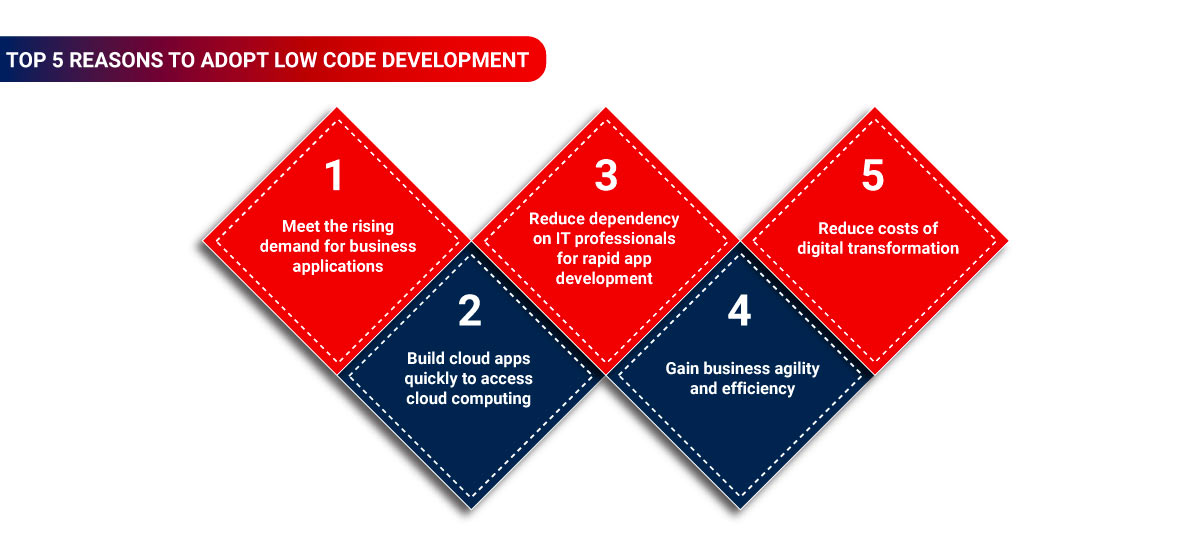The modern agile environment demands speedy application delivery and customized automation workflows. Traditionally, building a software solution or business application requires a lot of time, energy, and financial investment. The low code application development approach has been introduced to keep up with the changing business needs in software development. It helps elevate coding from textual to visual by altering and simplifying the development process.
With few to no programming skills, a low code development approach allows one to build applications and processes with basic logic, leveraging drag-and-drop capabilities.
Emerging product owners are turning to low code development because it helps teams innovate quickly without spending too much time writing and testing new scripts. One of the biggest advantages of low-code development is that it also costs much less, helps overcome developer shortages, and creates software faster to improve time to market.
This informative piece of content will discuss the concept of low code application development, its importance, key principles, how it works, its benefits, challenges, how to select the right low code platform, and more. So, let’s get started!
What is Low Code?
Low code is a modern alternative to traditional software development. It is a visual approach using a friendly graphical UI and drag-and-drop functionality with little coding. Since specialized computer programming knowledge is not required, non-IT executives can use low-code platforms to build value-driven applications.
It speeds up application development while reducing the reliance on traditional development methods. Low code democratizes application development by empowering “citizen developers” (having limited to no coding experience but domain knowledge) to contribute to software development.
How is Low Code Different From No Code
The terms ‘low code’ and ‘no code’ are often used together or interchangeably; however, they are different regarding the coding knowledge required. While the ‘low code’ method requires minimal coding, ‘no code’ targets users with little to no programming experience.
What is Low Code Development, and Why It Matters?
Low code development is a visual drag-and-drop software development approach that aims to simplify software development. While traditional software development was slow and time-consuming, Low code development seeks to simplify the software development process and speed up the delivery of applications.
This development approach benefits citizen developers and professional developers by eliminating complexity and reducing time in application development. So, if you don’t wish to build an application in-house and seek an external vendor, you can ask them to utilize low code platforms to create custom software quickly and cost-effectively. It is a smart way to cope with the high development demand and shortages of skilled developers. Low code application development has multiple benefits for your business, such as boosting business efficiency, agility, and productivity.
Let’s examine some statistics to understand why low code development is important.
Did you know?
- Non-technical individuals account for approximately 60% of users for low-code application development tools, and their share will increase by 80% by 2026, predicts Gartner[1].
- The key drivers for adopting a low code approach through 2026 will be the rising number of composable and hyper-automation business initiatives by enterprises, confirms Gartner[1].
- Additionally, the revenue of the global low code platform market is expected to increase by a CAGR of 26.1% from USD 22.5 Billion in 2022 to about USD 32 Billion by 2024, suggests Statista[2].
Why Should You Adopt Low Code Development?
Enterprise low code development platform offers many compelling reasons why businesses should adopt this approach. They include:

Faster Time to Market
Businesses must automate workflows to enhance efficiencies and meet customers’ demands better. Low code development allows you to build custom applications faster than traditional development. You can drag and drop pre-configured modules, pre-written code, and templates to enable faster delivery of applications.
Low code software development thus eliminates the need for hiring professional developers and promotes higher business efficiency. For example, companies like Sprint and The Salvation Army use a low code development approach to automate internal processes.
Build Cloud Applications Quickly to Access Cloud Computing
Businesses are increasingly moving to the cloud to provide flexibility and greater connectivity to their employees and customers. Cloud technology eliminates the need for hardware and costly maintenance while simplifying data storage and management. Using low code to build cloud-based applications helps businesses streamline and automate their workflows quickly.
Reduce Dependency on IT professionals for Rapid Application Development
In traditional development, developers were needed at every step. However, with low code development, companies do not have to depend on pro-coders to create affordable business solutions. Low code platforms reduce the involvement of experienced developers as citizen developers can complete the initial phases of software development. Skilled developers step in at a later stage to ensure the application built is scalable and secure.
Gain Improved Business Agility
As businesses grow and focus evolves, they must update applications to incorporate new processes or amend the existing ones. They can quickly complete these tasks in-house by utilizing enterprise low code development platforms to redesign the applications. Similarly, companies may want to replace legacy software with advanced ones that meet customers’ demands. Low code development helps them build applications capable of running on cross-functional platforms.
Reduced Costs for Digital Transformation
Traditional application development methods tend to increase costs because they involve writing complex codes at every stage of the development process. It requires the involvement of a highly skilled and experienced development team. Contrarily, low code development decreases cost as it shortens the software development cycle and reduces the involvement of expert professionals at every stage.
How Does Low Code Development Work?
The traditional software development process requires a complex development environment, testing, and deployment protocols. It relies on a highly skilled team of programmers, developers, testers, etc.
On the other hand, low code application development platforms adopt the visual programming approach that facilitates automatic code generation. These platforms are specifically designed for citizen developers and have features to edit and iterate.
Here’s what your low code development journey will look like:
- Determine Project Scope and Desired Outcomes: It includes defining the potential application users, the business issues this development must address, the benefits it must provide, etc.
- Documenting Desired Business Workflows and Processes: Identify the modules you require within the software by using low code business process management (BPM) and development tools.
- Draw Business Workflow: Build the application as if you are drafting a flow chart for every functionality and feature required. Visually select and connect reusable functional components. The low code development platform automatically generates the codes in the backend based on your visual inputs.
- Test/ Deploy Your Application: Getting your developed application tested by IT professionals, implementing their recommendations, and deploying the software for use.
The above-mentioned development process is also referred to as simply click or even point-and-click development.
Key Principles of Low Code Development
To leverage the benefits of low code for your application, you need to rethink and fine-tune your approach. You must follow sound technology and business principles to achieve the desired business outcomes. The important principles for low code software development include the following:

Selecting the Right Low Code Development Platform
It is essential to choose the most-suited platform to leverage full benefits. The choice must be based on the desired level of development required and the in-house team’s technical capabilities. Thus, investing time exploring different low code platforms could benefit the business in the long run.
Learning How the Low Code Platform Works
These platforms require your input to provide results. So, the involvement of all the stakeholders from the start is important. Spending time and effort in understanding the low code platform’s capabilities, functionalities, features, limitations, etc., will help you create better applications.
Having a Project Roadmap
A well-defined roadmap helps keep the project on track. It helps you avoid unnecessary iterations, which could cost you time and money.
Focus on Teamwork
AAll the stakeholders must form a stable, small, yet agile team and understand the needs and expectations of the proposed application. It helps collaborate better and make optimum use of resources. They should know the assumptions and proposed components within the low-code platform to be utilized. Also, they must have a clear picture of how the outcome will look. So, they can contribute to the testing and deployment stages and ensure they get the desired result.
Avoid Customizations or Keep Them Minimal
Low code development platforms provide predefined, reusable, drag-and-drop components that reduce time and effort in building applications. However, customizations require you to create new components or modify existing ones, defying the promise of the low code technology. So, avoiding customizations to meet your time and cost deadlines is better. However, if you must customize, design components with a long-term view that can be reused in other projects.
What are the Benefits of Low Code Application Development?
Low code development offers several advantages to businesses, leading to its increased popularity. They include:
Need for Speed
Traditional software hasn’t aged so well to keep up pace with today’s market demand to scale at speed. The drag-and-drop feature of the low code platform quickens the development. Easy-to-implement APIs and connectors that integrate with third-party tools mean that there is no learning curve. Usually, releasing the application is lengthy, but with low code, one-click software deployment takes the pain out of release days.
Niche projects
Low code is an excellent development option for small applications with a limited user base. For instance, a company may not want to invest in a tool specific to a particular department, or they may allocate a minimal budget for it. Low code development is cost-effective, fast, and suits such business needs.
Easy Access to the Latest Technologies
Low code platforms come with many built-in features and templates. It allows businesses to integrate the latest technologies, like Cloud Computing, Machine Learning, and Artificial Intelligence, into their software development process.
Increased Automation
Low code platforms use AI and ML to offer recommendations and suggestions based on the data sets utilized. Setting fundamental rules for decision-making within the platform and automating workflow designs allows you to execute them in other information systems.
Better Management and Control
It is easier to ensure compliance and governance with low code platforms as they abide by the established guidelines and monitor your project. They have analytics and reporting functionalities that help gauge your project’s performance, plan updates, and troubleshoot accordingly.
Seamless Data Integration
The low code approach helps users collect, process, and store data for workflows by identifying the data source, quality, ownership, and validity. It allows them to make informed decisions, making data integration flexible and simple.
Enhanced Customer Experience
Customers today expect faster updates and more personalized experiences. Low code platforms offer real-time updates, faster go-to-market, enabling organizations to deliver insights rapidly to customers. Customer Experience (CX) professionals can utilize these platforms to create loyalty or customer service applications, custom customer surveys, etc. Since it makes application development faster and easier, low code platforms allow businesses to respond quickly to customer feedback. This increase customer experience and brand loyalty.
Greater Privacy
Businesses may want to build applications that use sensitive data. However, they may find it too risky to outsource such development to third-party companies. So, low code development helps them digitize private information to avoid the risk of data breaches.
What are the Low Code Development Challenges?
Irrespective of several conveniences it provides, the low code development approach could pose some significant challenges to business owners, citizen developers, and even professional developers.
Knowledge Beyond the Tools
While low code reduces the requirement for coding, the users need knowledge of business practices and software development to optimally utilize this technology. When users with no programming knowledge build applications using low code platforms, professional developers often spend more time fixing the bad code. Without much coding experience and knowledge of IT security principles or framework, the ability to customize and adapt changes are limited. It is much easier and more cost-effective to avail low code development services and start with a good code.
Bloated and Unoptimized Code
Using reusable components from the low code platform to build applications creates underlying code. Due to the generic nature of components, the code created is more than the requirements of the tasks on hand and is usually bloated. Not optimizing this code results in inefficient functioning, increasing the size of the software built and impairing its performance. It’s better to go for quality, handwritten code to improve the efficiency of your software.
Hidden Complexity
Low code is most effective if the underlying code of your developed application functions as expected. Citizen developers often run into roadblocks and find that even the best of their intentions and strategies do not result in the expected outcome. And if there’s no one on the team capable of detecting errors and resolving them or checking if the application is secure enough to carry out business tasks, the entire exercise of low code development could turn out to be extremely expensive for the business.
Complexity Under the Hood
While the low code approach works best to resolve some business issues concerning programming, it cannot be used for all problems. It is better to utilize conventional software development approaches and tools for more complex tasks or ones requiring a good amount of customization.
High Possibility of Vendor Lock-in
While the low code approach works best to resolve some business issues concerning programming, it cannot be used for all problems. It is better to utilize conventional software development approaches and tools for more complex tasks or ones requiring a good amount of customization.
Low Code Development Use Cases
While the primary application of low code is to develop software with little to no development background, it offers many other use cases: They include the following:
Prototypes and MVPs
Pre-built modules, low code templates, and GUI tools help develop an MVP faster than traditional software processes. It enables you to build MVP at reduced costs and with less effort. Further, most low code platforms come with third-party integrations for various development scenarios. They also comply with multiple industry standards, which helps develop low code with less effort.
Applications for New Platforms
Low code platforms require minimal to no coding and have a large network of APIs that integrate with third-party tools. This translates into faster development and rapid innovation in latest technologies like virtual reality (VR), augmented reality (AR), etc. Therefore, companies are utilizing low code development platforms as a preferred route for multi-experience application development (MXDPs). It thus helps businesses engage with customers better, enhance retention, and increase revenue.
Automation of Manual Processes
An excellent use case for low code is building smart process applications or operational efficiency applications that automate manual processes. Building such software aims to increase process efficiency quickly and at a low cost.
Legacy Migration Applications
Modernize your legacy systems leveraging Low code platform to bridge the gap between legacy and modern applications. It requires no programming skills and thus enables faster delivery of legacy migration applications. These applications must-have new functionalities, but they must support old processes. Usually, the old software not capable of supporting new processes or providing the expected user experience are modified using legacy migration applications.
Bots
Low code platforms help build bots using Robotic Process Automation (RPA). It helps automate time-consuming and mundane processes across departments and business lines.
API development
Businesses can accelerate the development of the Application Programming Interface (API) using pre-built templates in low code platforms. APIs are software interfaces that help connect applications and allow them to exchange data.
Cloud-Native Applications
Unlike traditional coding practices, low code platforms offer a visual model-driven approach to transform and maintain complex microservices. That is difficult to achieve with traditional coding practices. Low code platforms simplify microservices by auto-generating Kubernetes and Docker files and pipeline code for end-to-end automation.
How to Choose the Right Low Code Platform?
Choosing the right low code development platform is imperative to ensure that your efforts lead to desired outcomes. As businesses have unique needs and expectations, the chosen platform must be able to meet them. Here are the key things to consider while selecting a low code platform for your business:
Prioritize End-Users
You must select the low code platform depending on the type of users in your company, citizen developers, fresh or experienced developers. It would help to choose a platform that can facilitate both experienced developers and non-tech employees to build software effectively.
Reusability
Your chosen platform must allow the reuse of your application’s code with useful connectors like business components, templates, widgets, plugins, etc.
DevOps and Hosting
The low code application development platform must offer DevOps functionalities like CI/CD, agile development, and disaster recovery to provide hosting flexibility.
Governance
The right low code platform must provide the users/developers adequate control by offering external API endpoints, connectivity between software, performance monitoring, etc.
Cross-platform Development
Depending on your business needs, check if the low-code platform will allow you to build web, mobile, and desktop applications.
Do you want to know more about low-code mobile app development for your enterprise? Read our detailed article to know more about its benefits, features, and challenges.
Scalability
It’s crucial to verify if the low code platform of your choice is capable of on-demand scalability to handle important business applications.
Intelligent automation
Your low code software development platform should leverage technologies like Artificial Intelligence (AI) and Machine Learning (ML) to simplify and automate complex processes.
Maintenance and support
The low code platform you intend to use to build important business software must provide end-to-end and post-development support so that it can cater to your application development requirements.
Quickly Build and Deploy Enterprise-Ready Digital Solutions With Rishabh Software
Low code development offers organizations a faster and more convenient path to digital transformation. Businesses can quickly configure, build and deploy desired software with minimal coding using drag-and-drop interfaces.
The low code approach is not just for citizen developers. Professional developers can use this approach to build mission-critical business applications faster. So, if you are looking for a helping hand to build software quickly at a tight budget, connect with us to get guidance on our Microsoft Power Platform consulting services.
Rishabh software is known for offering end-to-end digital process automation services, including low code rapid application development leveraging leading platforms. We have successfully empowered organizations like yours to transform business faster and innovate at both speed and scale.
Backed by unparalleled industry knowledge, ability, and expertise, Rishabh Software’s low code development service can accelerate your digital innovation.
Your Low-code Queries Answered
Q: Is Low Code No Code the Future of Software Development?
A: Yes, low code and no code are the future of enterprise software development as they advance daily. Several studies[3] suggest that they are likely to be used more by both citizen developers and professional developers.
Q: Will No code replace Developers?
A: No code development will neither replace highly skilled and experienced developers, nor will citizen developers replace junior developers.
Q: Low Code Application Development Features
A: Low code application development platforms offer many features like:
- visual coding capabilities,
- predefined modules for different tasks,
- drag and drop interfaces,
- monitoring,
- reporting, and more.
Q: What can you build with low code platforms?
A: You can use low code platforms to build a wide range of applications. They could include applications for operational efficiency, customer relationship management, process management, security systems, etc.
Q: Why are enterprises adopting low code?
A: Enterprises are adopting low code as they help them develop better workflows, improve collaboration among different teams, manage risks effectively, and overcome business and industry challenges.
Q: What is low code automation?
A: Low-code automation is a process that uses low-code tools to build, automate, deploy, and modify applications, workflows, and processes with little or no coding skills. It enables business users and developers to develop software solutions using a graphical user interface and drag-and-drop features. The major benefits of low code automation include improved agility, ease of use, and cost savings.
Footnotes:
1. https://www.gartner.com/en/newsroom/press-releases/2022-12-13-gartner-forecasts-worldwide-low-code-development-technologies-market-to-grow-20-percent-in-2023
2. https://www.statista.com/statistics/1226179/low-code-development-platform-market-revenue-global/
3. https://www.gartner.com/en/newsroom/press-releases/2021-06-10-gartner-says-the-majority-of-technology-products-and-services-will-be-built-by-professionals-outside-of-it-by-2024











 30 Min
30 Min


